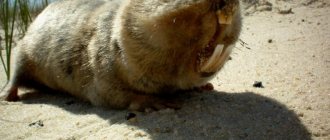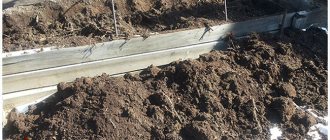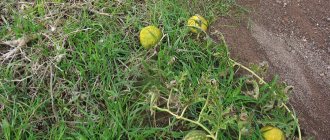Catching a ferret in a chicken coop is the primary task facing poultry farmers, if a predator has entered their household.
The fact that hunting is a natural instinct is little consolation: the animal must be gotten rid of urgently. There are several ways to combat ferrets, martens and weasels that have taken a fancy to the poultry house.
Each farmer chooses the most convenient option. It is in vain to hope that the ferret will leave on his own: having been in the chicken coop once, the predator will never forget the way there.
Signs of a predator appearing in a poultry house
Ferrets are very dangerous for chickens.
The peculiarity of a ferret is that, having entered the poultry house and seeing an abundance of food, the animal can destroy all the chickens in one night, although it is not able to eat so much prey.
This feature of the animal is especially harmful. In the excitement, a marten or polecat can kill even large birds - geese, turkeys. There are signs that make it possible to determine the presence of a predator near the poultry house before the first victims appear.
The animal’s attempts to enter the chicken coop are evidenced by the following:
- Chickens do not leave their roosts in the morning - the frightened bird sits on top, even when the owner comes in and pours out food. This behavior occurs when a predator is near the house.
- Chickens huddle on the highest perches and even in very crowded conditions refuse to sit lower.
- Poultry screams in the chicken coop at night - when they hear a ferret trying to get inside, the chickens wake up, start screaming, and make a long noise. When the owner appears, the bird does not calm down.
If a predatory animal has entered the chicken coop, signs of hunting become obvious. All or some of the chickens are killed. The bird's blood is drunk, its legs and head are often chewed off.
When there is a suspicion that a ferret has appeared near the chicken coop, immediate action must be taken. The very next night the bird can be completely destroyed. A trap is immediately placed on the predator, and the bird is transferred to a safe place, inaccessible to the uninvited guest.
Attention! When the ferret has completely destroyed the chickens, it makes no sense to get the bird again (until the hunter gets rid of it): the pest will kill new pets.
The first signs of impending danger
The ferret does not always begin his vigorous activity from the first call.
It happens that first he goes on reconnaissance. The chickens will immediately sense such a night visitor, and the next morning they will begin to behave differently. They become restless and try not to leave their nest. Having noticed such changes in the behavior of birds, it is necessary to immediately begin defense. If the farmer does not worry about this, he will one day find all his chickens dead. It is noteworthy that some poultry farmers specifically place ferrets and weasels in their farms. This helps when you need to get rid of hordes of rats in the attic and basement. Under these circumstances, the chickens will not be in danger. Ferrets do not touch anyone in their territory. But they are happy to go hunting in neighboring chicken coops.
What is the danger of ferrets, weasels and martens?
The particular danger of the predator is the mass destruction of poultry. Having entered the poultry house, the ferret, having eaten, begins to store food for future use.
Be sure to read:
Waterer for chickens and other birds: 5 great DIY options
The entire chicken flock often becomes prey. The hunting pattern of ferrets, weasels, and martens is the same: fishing continues as long as there is a living bird in the chicken coop.
If the predator is scared off, the hunt will continue the next night. It is important for the farmer to prevent such attacks.
Chicken coop after a visit from a predator
The skeletal features of the ferret and weasel allow the animals to easily penetrate through small holes and narrow cracks, significantly complicating the protection of the chicken coop in the habitats of these predators. It is easier to protect the poultry house from rats.
Important! Large aggressive roosters can kill ferrets while protecting the hens. The rooster is powerless against experienced hunters who regularly hunt poultry.
About caresses
The weasel is a unique animal, because there is no predator smaller than it in nature. The weight of a male can be 60 g and never exceeds 0.25 kg.
The body length of adult males varies between 15 cm - 25 cm, and in females 10 cm - 25 cm. In appearance, the weasel is more similar to an ermine than a ferret. The forest ferret looks more like a mink.
Inexperienced farmers, having caught a black ferret, often think that they managed to catch a mink in the chicken coop.
The weasel has the outer part of its paws and tail, as well as the top of its head and back, a uniform brown color with a brownish tint. The fur on the belly, throat, chest, and inside of the paws is perfectly white. A distinctive feature of the weasel is two brown spots at the corners of the mouth. In winter, it changes its brown fur to a white winter coat. Small dimensions allow the weasel to settle in hollows, between stones, and in empty holes. These animals often live in colonies, which makes them different from ferrets.
The weasel feeds on mouse-like rodents, moles, small amphibians, birds and their oviposition. Predators of the mustelid family are sensitive to odors of animal origin.
However, the weasel loves the smell of horses and often attacks stables. This small animal tickles the horse throughout the night, bringing the poor animal to complete exhaustion. To rid the stable of this scourge, experienced farmers keep a goat next to their horses, the smell of which the weasel cannot digest.
What traps to use
To catch ferrets, traps of different models are used. Given the nocturnal lifestyle of the predator, the trap is set in the evening. Using traps, they ensure the safety of chickens: they place the traps in a place inaccessible to the birds.
After installation, traps must be treated with a special compound that repels the human odor that frightens predators.
They use a product sold in specialized stores, manure (the trap is coated with the substance), slaked lime (applied with a brush). If the location of the ferret's hole is known, a trap is placed nearby.
To catch a predator, they use the so-called. trap No. 1. The device's guard is made especially sensitive. The bait is a bird killed by a polecat, and the animal's blood is poured into the trap.
A rat trap that is strong enough to hold a large rodent is a suitable trap for a ferret. The device is additionally weighted by attaching it to a large board to make the trap stable.
The ferret overturns a light rat trap, vigorously escaping. The freed predator, remembering the dangerous trap, always bypasses the rat traps.
Use of pets
If a ferret has already gotten into the habit of entering your chicken coop, then, sadly, the animal must be caught.
Pets - cats, dogs - help many farmers by protecting chicken coops from ferrets. They scare away predators, making it difficult to calmly hunt the bird.
The ferret is an active, cautious animal, so it is difficult to catch the enemy of poultry birds, but some pets are valuable hunters. Agile dogs and cats are capable of unexpectedly grabbing and crushing a ferret, weasel, or marten.
Important! Pets that hunt predators must be vaccinated against rabies.
Ferrets and other breeds of domestic ferrets are useful to farmers. They catch rodents by driving wild polecats out of their territory. Well-fed pets do not hunt birds. You should not allow tame ferrets only to the chicks: the chicks will turn out to be a toy for hunting and entertainment.
General characteristics of the predator
Ferrets belong to the mustelidae family of mammals. Ferrets have an elongated body and are particularly flexible and agile. These animals are excellent at climbing the tallest trees and digging deep holes. Males are slightly larger than females.
The habitats are very different, it depends on the type of animal. Ferrets often move closer to human habitation. There are usually two types of ferrets found in Russia - the steppe white and the forest black. Under favorable conditions, ferrets lead a sedentary lifestyle in their own territory. And only hunger can push them to human habitation, where there is always food for them.
The basis of any ferret's diet is food of animal origin. They hunt and eat birds, rodents, insects, reptiles and even poisonous snakes. A ferret will never miss a nest with eggs. He will drink them all and destroy the nest. Large individuals can become a real threat even to hares and muskrats.
Thanks to their agility and endurance, ferrets can pursue their prey for a long time. But, as a rule, they prefer to watch for prey near its own hole. The peak of hunting occurs at night, but if night hunting is not successful, the ferret will do it during the day. Ferrets are not attracted to plant foods.
Homemade traps
Some farmers catch animals with homemade traps.
The simplest version of the device is a bucket or box with a support. The bait is a piece of meat containing a large volume of blood.
Be sure to read:
How to make a chicken feeder: drawings, dimensions, examples from wood, plastic bottles and pipes
The support is positioned so that the animal knocks it down by pulling the bait. The downside of the trap is the need for constant checking, otherwise the ferret will have time to get out. The caught animal must be removed quickly.
More reliable is a cage that has a vertically lowering door held open by a rope, which is released as soon as the bait is touched. To attract the animal, meat is taken with copious amounts of blood.
Care should be taken when removing a captured ferret. The teeth of polecats, martens, and weasels are very sharp, easily bite through the skin, and damage joints.
A wild animal may be infected with the rabies virus. Thick, thick mittens are put on your hands, and thick leather gloves underneath. It is convenient to use a lasso when getting a predator out of a trap.
You should not try to tear off a ferret that has grabbed your hand: the injury will be worse. The animal's nose is pinched to loosen its grip, then a wooden stick is inserted between the jaws and the mouth is opened.
A cage with a vertically lowering door is more reliable.
After being bitten, you should immediately seek medical help and get vaccinated against rabies. You should try to take your ferret to a veterinary laboratory for diagnosis.
What to do with the captured animal is up to the poultry farmer to decide. If possible, you can act humanely: release the ferret far into the forest, from where the animal cannot return. When long-distance release is not possible, the pest must be destroyed. The skin of a healthy animal is used.
Some farmers know how to catch polecats with a rope lasso. The method is complex and requires experience. If the hunter's skill is insufficient, the animal will easily escape the noose and become more careful.
Important! Experts do not recommend using homemade products for catching polecats, but recommend professional devices that provide guaranteed results.
How to scare away a ferret, marten, weasel
Electronic devices have been developed that create ultrasound. It causes fear in the predator and forces the animal to leave the territory covered by the repeller.
Live trap diagram
The device does not bother other animals. The person doesn't hear him. The disadvantage of an ultrasonic device is the possible addiction of the predator, the disappearance of the scaring effect.
Low frequency repellers are not addictive. The sound always seems to be the animal signal of an approaching earthquake. However, the device has a negative impact on pets that sense low-frequency sounds. Chickens experience stress when the appliance is operating.
There are light repellers that have a motion sensor. When fixing a moving object, the device turns on a flashlight, the light of which, frightening, drives the animal away from the chicken coop.
The disadvantage of the light repellent method is the inability to completely cover the entire area around the building, so persistent ferrets will be able to enter the chicken coop through an unlit area. A light repeller, additionally equipped with a sound function, is more effective.
Be sure to read:
How to make a perch for laying hens with your own hands correctly: drawings, photos, videos, dimensions
Folk methods of struggle
Important! Folk measures against polecats, martens, and weasels are sometimes used by small farm owners, but there is no official confirmation of the effectiveness of such protection.
It is recommended to lubricate the surface of the walls of the building with tar. The substance should repel predators, but not all animals are afraid of the tar smell. If the foundation of the building is not sufficiently strengthened, the ferret will dig, bypassing the area with tar.
There is an opinion that goat skin drives away ferrets with its smell. The smell of a goat is said to frighten all members of the mustelidae family. It is difficult to get rid of the animal this way. The method is more correctly classified as preventive measures for a well-insulated poultry house.
The folk method is to catch an animal using a strictly heavy coat or jacket. Special dexterity is required from a person. The animal must be quickly covered and wrapped in a coat.
The ferret should be pulled out by the withers, after putting on gloves and mittens.
It is unacceptable to involve children in this matter. Catching a ferret using a jacket or coat is dangerous and is not advisable. Wild animals carry many diseases, so it is advisable to avoid contact.
Ferret and methods of dealing with it
The ferret belongs to the mustelidae family. He is very angry and fast. The forest ferret is squat with short and strong legs. Its body is long, adapted to penetrate narrow holes and burrows. He chooses his habitat once and does not wander from one forest to another. Glades and forest edges are its favorite habitats. He prefers not to go into the thicket of the forest.
They live in minks. Most often, he digs them on his own, but if for some reason he cannot do this, he takes empty fox or hare holes. The wild ferret prefers to feed in the forest.
He eats:
- small rodents;
- reptiles;
- birds;
- worms;
- fish.
His stomach is not able to digest plant food, so he gets all the useful substances by eating herbivores.
In one visit, a ferret can destroy 10-15 chickens
During periods of food shortage in the forest, the animal raids villages and villages that are located close to the forest. There he climbs into the chicken coops and destroys all the birds.
How to Avoid a Predator
If there is a risk of a ferret appearing in the chicken coop, the poultry farmer should take preventive measures in advance and provide for the protection of the structure from penetration of predators during the construction process:
- Completely isolate the room. Make the foundation monolithic concrete, cover the floor under the boards with iron. Cover the walls of the chicken coop with fine mesh and seal the cracks with cement.
- The ventilation system should be installed at a height of at least 2 meters from the ground.
- Close the coop tightly at night. Place a lock or latch on the door: the hook can be opened by the animal.
- There should be no accumulation of things inside the premises: any shelter will allow a predator, entering the chicken coop during the day, to remain unnoticed.
- Equip the walkway around the perimeter with a concrete strip , which should go to a depth of 50 cm.
- In places where the risk of a predator is high, inspect the chicken coop and poultry run daily. Suspicions of the appearance of an animal require urgent additional protective measures to be taken.











